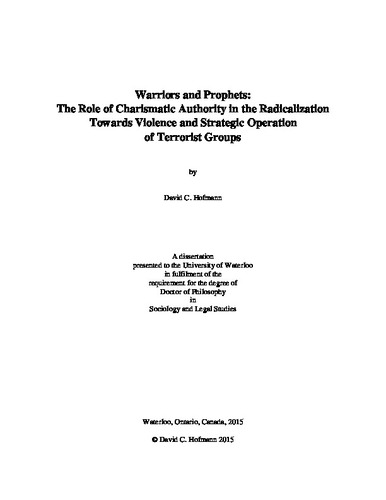| dc.description.abstract | In the past four decades, there has been increased multi-disciplinary scholarly interest in the study of charismatic authority and charismatic leadership. However, there is little systematic theoretical and empirical examination of charismatic authority and charismatic leadership in the context of terrorism, despite widespread acknowledgement of the importance of charismatic leaders in the formation, operation, and demise of terrorist groups. This dissertation seeks to re-orient and stimulate future scholarship through an in-depth theoretical and empirical analysis of the relationship between charismatic authority, the radicalization towards violence, and strategic operation of terrorist groups. The introductory chapter grounds the subsequent research by providing working definitions of core concepts, reviewing the current literature on terrorist leadership, discussing methods to improve future analyses of terrorist leadership, before ending with a brief consideration of methods, data, and research questions. Chapter 2 is a critical examination of how the current terrorism literature misuses the social-scientific concepts of charisma and charismatic authority. After examining where and how the literature has fallen short, it provides a synthesis of the available multi-disciplinary social-scientific research on charismatic authority, identifies the three common ways in which the concept of charisma is commonly misused in terrorism studies, and explores several challenges and opportunities for future research. Building upon this foundational analysis, chapter 3 contributes to future research by presenting and justifying a theoretical framework for measuring the presence of charismatic authority in terrorist groups based upon Max Weber’s seminal work on legitimate domination (herrschaft) and on theoretical insights drawn from the study of charismatic leadership in new religious movements. This framework is then applied to an illustrative case study of the relationship between the presence of charismatic authority and the radicalization towards violence within the far-right terrorist group ‘The Covenant, the Sword, and the Arm of the Lord’. Chapter 4 applies the same theoretical framework to a quantitative analysis of the relationship between varying levels of the presence of charismatic authority, choice in operational tactics (e.g., weapon and target choices), and results of attack outcomes (e.g., success rates, lethality) within a sample of thirty international terrorist groups. The concluding chapter provides a synthetic summary of the findings, discusses the contributions of the dissertation to the literature, makes several policy-relevant suggestions, considers study limitations, and outlines avenues for future research. | en |

